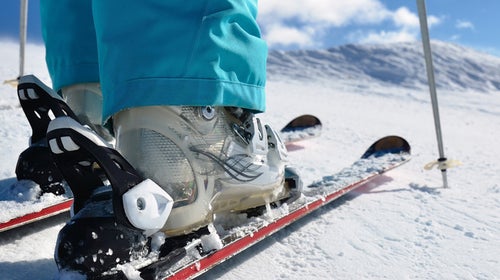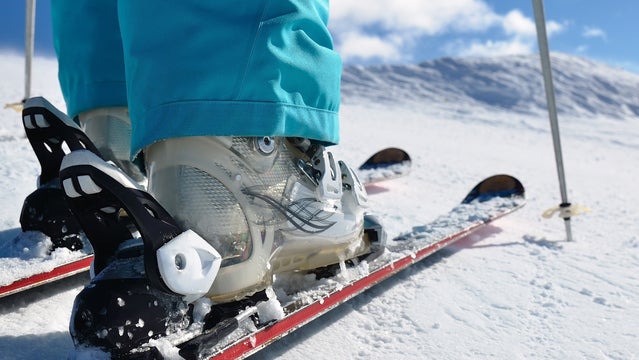Buying ski boots that fit well can be the hardest part of skiing. Think about it: you’re jamming 100 muscles, 26 bones, 33 joints, and a whole bunch of tendons, ligaments, and nerves into a rigid plastic shell with a liner that needs to be broken in or heated and fit to your foot to feel good.
The Snow Report
The latest snow, ski, and winter sports stories from ���ϳԹ���.To ski well, you need all of those parts to flex and move. A well-fitting boot won’t constrain your foot’s natural function and it will put you in a neutral position on the snow, a position that let’s you feel and respond to what’s going on underneath your skis.
Some master boot fitters, including Jeff “Ernie” Ernst, 29-year boot fitting veteran and owner of Park City, Utah’s , say that any skier—from beginner to expert—will be better off in custom boots. Steve Cohen, founder of and CEO of , thinks that stock boots will work for most people. But both agree on this point: getting set up properly by a trained fitter in a boot that roughly mimics your foot shape on an insole that supports it will result in endless days of shredding without foot, knee, or back pain.
“When you’re buying ski boots, you’re not just buying a product, you’re buying the service that goes with it,” says Cohen. “And that service will make the difference between a great day, week, or season on the slopes, and a ski season you’d rather forget.”
Buying new boots or ready to get the ones you already own to work? Here are some options for setting yourself up for your best performance on snow.
CHOOSE A GOOD SHOP AND A FITTER YOU TRUST
“Choose a boot fitter who has been at this for a while,” advises Cohen. “Boot fitting is part heart and part science, but not a lot of mystery. If you go into a store and they ask you what size you wear, walk out.” “Avoid sporting goods stores when you’re buying boots,” agrees Ernie. “Find a specialty retailer or boot fitter with one or more experienced technicians on staff. You’ll have more fun skiing, and in the long term it’ll save you money.” Cost: free.
GET IN THE RIGHT BOOT SHELL SIZE
“Have a boot fitter, not a sporting goods store, evaluate your shell—if you’re not in a boot that’s the right size for your foot and the right shape for your foot, nothing else will help,” warns Ernie. To correctly size a ski boot shell, a boot fitter will first measure the width and length of each foot. He’ll evaluate your instep height and your heel and forefoot width as well as your shin diameter. Then, he will remove the liner from your boot and check how much space you have when you stand barefoot in the liner-free shell with your toes lightly brushing the front of the boot. He’ll measure behind your heel for a finger to finger and a half (3/4 inch to an inch) of space. Cost: free.
BUY A SUPPORTIVE FOOTBED
“Any good boot fitter won’t do anything to your boot or liner until he has your foot stabilized,” says Cohen. “And 90 percent of fit issues can be solved with a supportive insole. It’s like building a good house in some respects—the foundation matters.”
Already have an aftermarket insole? Check if it’s doing what it’s supposed to by removing it from your boot. If you see dark, dirty marks under your toes, but no wear or use under your arch, then the insole is not doing its job properly.
Off the shelf ski-specific semi-custom insoles, like , or , support your foot, cradle it in your boot, and help your brain process what’s happening underneath you. With your arch supported, your foot has more contact area, which means more information for your processor about where you are in space, and what you need to do to manipulate your skis. “If you’re looking for the most affordable way to improve your performance,” says Ernie, “this is it.” Cost: $40-$70.
For anyone who skis a lot, has foot pain, “hard to fit feet,” past injuries, or feet that are radically different shapes or sizes, custom insoles are step one toward a better skiing position. A trained technician will evaluate your foot, choose the correct insole, and heat mold it to you. Cost: $80-$225.
MOLD YOUR BOOT SHELL TO YOUR FOOT
If you’re getting odd pressure points, or you have ankle spurs, heel spurs, bunions, particularly wide feet, or other special foot physiology, a boot fitter can modify your existing shell using heat guns, dyes, and grinders. When the shell fits, your ankle has room to articulate for best ski feel and balance, and your forefoot can flex and move. “If your foot is locked down,” says Ernie, “you have to compensate with your upper body.” Don’t try this at home. Hair dryers don’t provide enough heat, and messing with your shell is the best way to screw up a pair of boots if you don’t know what you’re doing. Cost: $25 per area modified, up to $75-$100 per boot.
ACCELERATE YOUR LINER’S BREAK-IN TIME
Backcountry boots come with a liner that’s supposed to be heated and molded to your foot before you ski. Most alpine boots don’t have a thermomoldable liner. “But heating your boot liner accelerates the break-in process, and helps your boots be comfortable sooner,” says Cohen. Don’t try this at home—ski shops and boot fitters have special ovens to heat your liners enough so that they can be molded, but not so much that they melt. Typically a shop will heat your liners, then have you stand in them in ski socks on your insoles with the boots lightly buckled for 20-30 minutes. Cost: free-$25.
TWEAK OTHER ISSUES AS NECESSARY
If you’ve had insoles made, gone through a shell fit, and heat molded your liners but still feel like you can’t pressure your skis evenly on slope, you may be out of alignment. A boot fitter will put you in ski socks in your boots and look at the relative position of your knees, ankles, and hips. If the fitter determines that you’re off center, he might plane your boot sole to correct the problem, or align your cuff with your foot. If you have pressure on the outside of your foot—often called sixth toe pressure—or ankle bone pressure, or a “ring of fire” on your calves, your boot tech can modify your liner, spot compressing it, removing foam or an offending seam. It doesn’t take much for a foot to feel discomfort and pain. And it’s often quick and easy to make that pain go away. Cost: $25 per change, or an hourly rate of $60-$75.
FULL CUSTOM BOOT FIT
Ernie and other boot fitters will tell you that the happiest skier is one that has had a full custom fit. A full service fit incorporates all of the steps outlined above to put the skier in the best position possible in a boot that’s comfortable and responsive because it conforms to the shape of the skier’s foot. Cost: $400-$600 with existing boots, $1,200-$1,500 with new boots.


